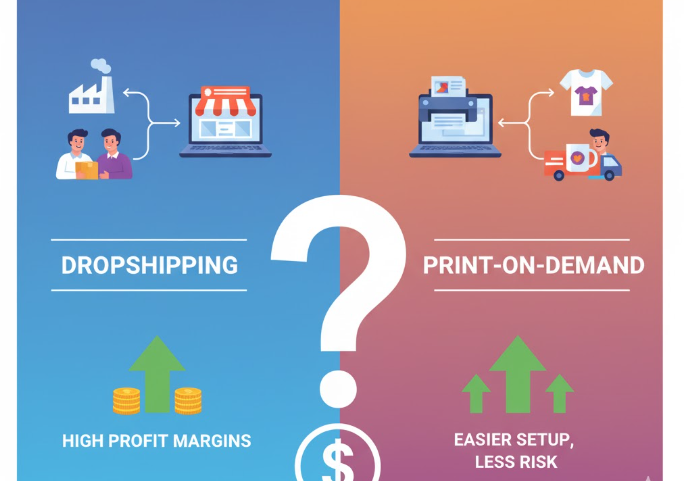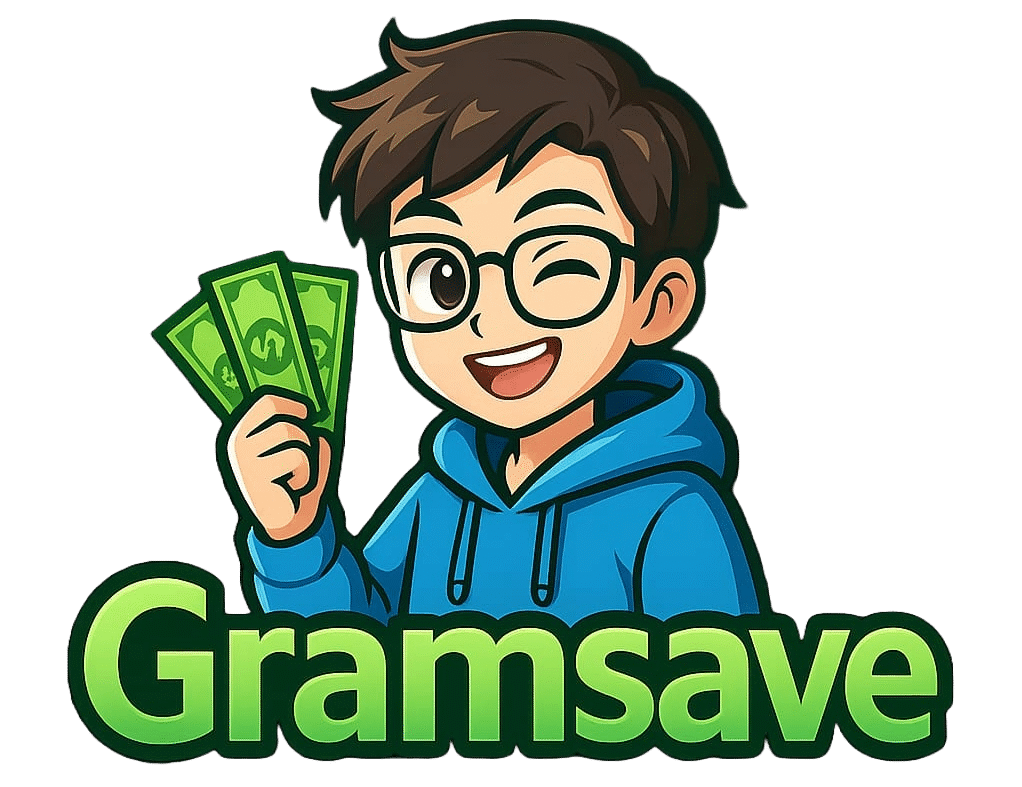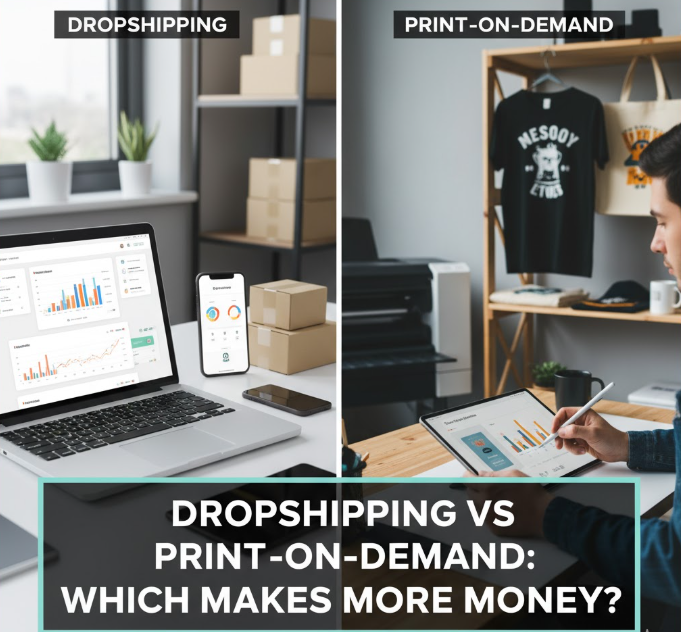Introduction: Two Popular Online Business Models, One Big Question
If you’ve ever dreamed of starting an online business without holding inventory, you’ve likely come across two hot models — dropshipping and print-on-demand (POD). Both promise low startup costs, flexible working, and the chance to earn passive income. But when it comes down to the ultimate question — which one actually makes more money? — the answer isn’t as simple as it looks.
Dropshipping and print-on-demand share some similarities. They both let you sell products online without buying stock upfront. However, they differ in the type of products you sell, profit margins, branding freedom, and how easily you can scale.
This article breaks everything down — profits, setup, competition, scalability, risks, and long-term potential — so you can decide which business model fits your goals and wallet.
What Is Dropshipping?
Dropshipping is a retail fulfillment method where you sell products online without storing or shipping them yourself. When a customer buys something from your store, you forward the order to your supplier, who then ships it directly to the customer.
How It Works (Step-by-Step)
-
You list products from a supplier (like AliExpress or CJ Dropshipping) in your online store.
-
A customer places an order on your website.
-
You pay the supplier for that product at a wholesale price.
-
The supplier ships the item directly to your customer.
-
You keep the profit — the difference between your selling price and supplier cost.
Example
Let’s say you sell a Bluetooth speaker for $60, but your supplier charges $30. You keep the $30 profit (minus small fees).
Popular Platforms for Dropshipping
-
Shopify + DSers/AliExpress
-
WooCommerce + Spocket
-
Etsy (for certain categories)
-
Amazon dropshipping (with limits)
What Is Print-on-Demand (POD)?
Print-on-demand is a customized version of dropshipping. You design unique graphics for products like t-shirts, mugs, phone cases, hoodies, or posters. When someone buys your design, the POD service prints and ships the item under your brand name.
How It Works (Step-by-Step)
-
You upload your artwork or text designs to a POD platform.
-
A customer orders a product with your design.
-
The POD company prints it, packages it, and ships it directly to your customer.
-
You earn a profit after production and shipping costs are deducted.
Example
You sell a custom “Coffee Lover” t-shirt for $28, while the POD provider charges $14 to print and ship it. You make $14 profit per sale.
Popular POD Platforms
-
Printful
-
Printify
-
Teespring (now Spring)
-
Redbubble
-
Gelato
Dropshipping vs Print-on-Demand: Key Comparison
Here’s a quick look at how both business models stack up:
| Feature | Dropshipping | Print-on-Demand |
|---|---|---|
| Startup Cost | Low (no inventory) | Low (no inventory) |
| Product Type | General (gadgets, tools, accessories, etc.) | Custom (t-shirts, mugs, posters, apparel) |
| Profit Margin | 10–40% | 30–60% |
| Branding Control | Limited | High (custom branding, packaging) |
| Competition | Very high | Moderate |
| Scalability | Easier | Moderate (depends on designs) |
| Fulfillment Speed | Depends on supplier (often slow) | Usually faster |
| Customer Loyalty | Low | High (unique designs attract repeat buyers) |
| Best For | Quick setup and testing trending products | Building a long-term creative brand |
Which One Makes More Money? Let’s Break It Down
To find out which model is more profitable, we need to compare revenue potential, profit margins, customer retention, and scalability.
1. Profit Margins
-
Dropshipping:
Average profit margins are 10–40%, depending on the niche and supplier. Cheap products like phone accessories or kitchen gadgets often have low margins due to heavy competition. -
Print-on-Demand:
Margins are generally 30–60% because you’re selling custom designs that customers can’t find elsewhere. Creative branding lets you charge more per item.
🧩 Verdict:
Print-on-Demand wins here — higher margins due to customization and brand value.
2. Initial Setup & Cost
Both models have minimal startup costs, but the difference lies in time and design work.
-
Dropshipping Setup:
You can launch a store within a day using pre-made product listings. You mainly spend on:-
Shopify subscription ($25/month)
-
Domain name ($10–15/year)
-
Marketing (Facebook or TikTok ads)
-
-
Print-on-Demand Setup:
You’ll need to create or buy designs (using Canva or hiring on Fiverr). The rest — website, domain, marketing — remains the same.
💡 Verdict:
Dropshipping is faster to launch and test, while POD takes more creative work.
3. Branding & Uniqueness
-
Dropshipping:
You sell the same generic products thousands of others sell. Branding is harder unless you private label your products. -
Print-on-Demand:
Every product can carry your logo, unique designs, or personalized message — ideal for building a recognizable brand.
🎯 Verdict:
Print-on-Demand clearly wins. Stronger branding = loyal customers and higher lifetime value.
4. Scalability
-
Dropshipping:
Easy to scale — just find more winning products and run ads. You can test 100 products quickly. -
Print-on-Demand:
Scaling takes creativity. You must constantly create new designs or expand into new niches (fitness tees, pet mugs, etc.).
🚀 Verdict:
Dropshipping wins for scalability, especially for entrepreneurs who rely on paid ads and product testing.
5. Customer Retention
-
Dropshipping:
Customers rarely remember where they bought a generic product from. Once the sale is done, they move on. -
Print-on-Demand:
People buy from your brand because they connect with your style or message. That means repeat buyers and long-term brand loyalty.
❤️ Verdict:
Print-on-Demand wins for customer retention and long-term profits.
6. Risk & Refunds
-
Dropshipping Risks:
-
Supplier delays
-
Poor product quality
-
Long shipping times (especially from overseas)
-
Higher refund rates
-
-
Print-on-Demand Risks:
-
Quality depends on printer service
-
Limited control over fulfillment
-
Difficult to replace defective custom items
-
⚖️ Verdict:
Both carry risks, but dropshipping often faces more complaints due to inconsistent suppliers.
7. Long-Term Income Potential
Let’s visualize the long-term earning potential for both models.
| Duration | Dropshipping (Average Earnings) | Print-on-Demand (Average Earnings) |
|---|---|---|
| 1st Month | $100–$300 (testing) | $50–$200 (setup & testing) |
| 6 Months | $1,000–$3,000/month | $800–$2,500/month |
| 12 Months+ | $3,000–$10,000/month (if scaled) | $2,000–$8,000/month (if brand grows) |
📊 Profit Trend Insight:
-
Dropshipping earns faster if you find trending products early.
-
Print-on-demand earns slower but builds stable recurring income through brand loyalty.
Case Studies: Real-World Profit Examples
1. Dropshipping Example – Trending Gadget Store
-
Startup Budget: $300
-
Winning Product: LED Pet Collar
-
Ad Spend: $500/month
-
Monthly Revenue: $5,000
-
Net Profit: Around $1,200/month
💡 Observation: Quick results possible, but requires constant product research and paid ads.
2. Print-on-Demand Example – Custom T-Shirt Brand
-
Startup Budget: $250
-
Platform: Printful + Shopify
-
Niche: Funny quotes + cat lovers
-
Monthly Revenue: $4,000
-
Net Profit: Around $1,500/month
💡 Observation: Slower start, but sustainable long-term growth due to loyal audience.
Pros and Cons of Both Models
| Aspect | Dropshipping | Print-on-Demand |
|---|---|---|
| Pros | Low startup cost Quick to test new niches Huge product variety High scalability |
Unique branded products Better profit margins Customer loyalty No inventory or shipping stress |
| Cons | Heavy competition Low margins on generic items Unstable supplier reliability |
Requires creative designs Slower to scale Limited to specific product categories |
Profitability Factors That Matter Most
To decide which model will make you more money, consider these five key factors:
1. Niche Selection
-
Dropshipping: Profit comes from trending or problem-solving items (e.g., posture correctors, kitchen tools).
-
POD: Profit depends on creative or emotional connection with your audience (e.g., “Dog Mom” shirts, gamer mugs).
2. Marketing Skills
Both models heavily rely on digital marketing:
-
Dropshipping: Facebook, TikTok, and influencer ads are key.
-
POD: Organic traffic through Etsy, Instagram, or Pinterest can work wonders.
3. Customer Lifetime Value (CLV)
Print-on-demand wins here. A loyal buyer might purchase multiple designs over time.
4. Automation & Outsourcing
Dropshipping can be fully automated using apps. POD also integrates easily with Shopify or Etsy for auto-fulfillment.
5. Creative Advantage
If you enjoy design and storytelling, POD gives you a long-term competitive edge. Dropshipping relies more on data and trend-chasing.
Which One Is Easier for Beginners?
| Criteria | Easier Option |
|---|---|
| Fast Launch | Dropshipping |
| Creative Freedom | Print-on-Demand |
| Learning Curve | Dropshipping (less design work) |
| Passive Income Potential | Print-on-Demand (after building audience) |
SEO and Organic Growth Opportunities
Many new entrepreneurs overlook one crucial point: search engine optimization (SEO).
-
Dropshipping SEO:
Harder to build because most stores use duplicate product descriptions. Search engines prefer unique content. -
Print-on-Demand SEO:
Easier — you can write original descriptions, use design keywords, and rank on Google or Etsy for specific phrases like “funny nurse shirts” or “dog dad mugs.”
🌱 Verdict:
POD stores have better long-term SEO potential.
Marketing Strategies That Boost Earnings
For Dropshipping
-
Run short, high-converting TikTok or Facebook video ads.
-
Use urgency tactics (limited stock, countdown timers).
-
Target problem-solving products with emotional appeal.
-
Offer upsells and bundles to increase average order value.
For Print-on-Demand
-
Build a social media page around your niche (e.g., pet lovers, fitness quotes).
-
Encourage user-generated content — people love showing off your designs!
-
Launch limited-edition collections to boost demand.
-
Focus on storytelling — connect your designs to emotions.

Dropshipping vs Print-on-Demand: Which Makes More Money?
Cost vs Profit Chart
Below is a simple comparison of how much profit you might make on average per product:
| Product Type | Cost (to Supplier) | Selling Price | Profit Margin | Avg. Monthly Sales | Monthly Profit |
|---|---|---|---|---|---|
| Dropshipping Gadget | $20 | $35 | 43% | 100 units | $1,500 |
| Print-on-Demand T-shirt | $14 | $28 | 50% | 80 units | $1,120 |
| Print-on-Demand Hoodie | $25 | $50 | 50% | 50 units | $1,250 |
💰 Both can earn solid profits — but POD gives better control and repeat sales.
Scalability Chart (Effort vs Earnings)
| Effort Level | Dropshipping Income Potential | POD Income Potential |
|---|---|---|
| Low Effort (part-time) | $500–$1,000/month | $300–$800/month |
| Medium Effort | $1,500–$3,000/month | $1,000–$2,500/month |
| High Effort (full-time, ads & brand building) | $5,000–$15,000/month | $4,000–$10,000/month |
📈 Takeaway: Dropshipping scales faster, but POD offers stable, long-term profits with brand loyalty.
Tips to Maximize Profits (Both Models)
For Dropshipping:
-
Choose trending products early using tools like Sell The Trend or Ecomhunt.
-
Optimize your store speed and checkout process.
-
Negotiate better prices with suppliers for higher margins.
-
Add upsells and email marketing for repeat sales.
For Print-on-Demand:
-
Focus on niche communities (nurses, gamers, pet owners).
-
Use Etsy SEO to rank your designs organically.
-
Test multiple design variations and track performance.
-
Offer personalized products (name, quote, or color customization).
Final Verdict: So, Which One Makes More Money?
Let’s summarize the ultimate comparison:
| Category | Winner |
|---|---|
| Profit Margin | Print-on-Demand |
| Setup Speed | Dropshipping |
| Branding Power | Print-on-Demand |
| Scalability | Dropshipping |
| Customer Loyalty | Print-on-Demand |
| Long-Term Stability | Print-on-Demand |
| Short-Term Income Boost | Dropshipping |
✅ Conclusion:
If your goal is quick cash flow, go for dropshipping — it’s easier to scale fast with the right ads.
But if you want to build a sustainable online brand with higher profit margins and repeat buyers, print-on-demand wins in the long run.
Both models can make you $1,000+ per month when done strategically, but the difference lies in your skills and interests:
-
Are you good at spotting trends and marketing fast? → Try Dropshipping.
-
Are you creative and want to build a real brand? → Go with Print-on-Demand.
Final Thoughts
Dropshipping and print-on-demand aren’t rivals — they’re two sides of the same coin. In fact, many smart entrepreneurs combine both. They start with dropshipping to learn product research and ads, then move to print-on-demand to build a lasting brand.
No matter which one you choose, remember this: success comes from testing, learning, and staying consistent. Both can change your financial future — if you treat them like real businesses, not get-rich-quick schemes.

